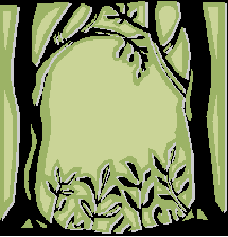



Regenerative factors and sections
Buried seeds in the soil, as well as recently dispersed seeds, contribute
to the development of secondary vegetation. However, the share of soil-stored
seeds to forest regrowth appears more important, especially when land use
intensity before abandonment has been low-to-moderate. Even though the density
of soil-stored seeds is reduced when the site has been burned its contribution
to immediate post-disturbance regrowth is usually much more than that of recently
dispersed seeds for most species (Young et al., 1987). Increased levels of
incident light or temperature stimulate seed germination of early colonizing
species. Although there is large variation in seed longevity in the soil
in those tree species that dominate secondary stands, it usually does not
exceed 1 year after dispersal. Thus, canopy dominance of light-demanding
tree species during secondary succession is largely dependent on recent seed
dispersal following site abandonment. Therefore, the probability of site colonization
may be low for those tree species that either do not reproduce annually,
or that are located at a critical distance, as spatial limitations to seed
dispersal into open areas may be very strong only a few meters beyond the
forest-non-forest interface. This causes for extraordinarily slow regrowth
rates.
As intensity of land use increases, the potential of secondary forests
to regenerate from soil-stored seeds diminishes. For example, Aide and Cavelier
(1994) suggest that in severely degraded grasslands in the Sierra Nevada de
Santa Marta, Colombia, forest regeneration from the seed bank is of minimal
importance. Usually, the vegetation that develops right after clearing of
old-growth forest tends to be poorer both in terms of species richness and
abundance than that arising from cleared sites previously supporting successional
vegetation. Because most of their component canopy species are unable to regenerate
in the understory, drastic canopy removal seems necessary for sustained tree
regeneration after timber harvesting; but at the same time, there is a high
potential for competing vegetation that arises from the seed bank to interfere
with tree seedling establishment and growth once the canopy has been opened.
This scenario is likely to occur in secondary stands as a rule, as they are
usually located within agricultural land.
Post-dispersal seed fate
After seeds are dispersed, another important obstacle to tree establishment
can be seed predation. Seed removal (a surrogate of predation) was higher
in abandoned slash-and-burn farms than in adjacent forest in the upper Río
Negro, Venezuela also reported in Paragominas, Brazil, higher rates of seed
removal by ants and rodents (>80% removal within 20 days for six out of
11 tree species examined) in abandoned pasture than in adjacent forest. In
their study, the probability of seed arrival into pastures was higher for
smaller-seeded species, but the probability of seed predation in the pasture
was lower for larger-seeded species. Therefore, small-seeded species were
not as dispersal limited as large-seeded species, but these on the contrary,
had a greater chance of getting established. In contrast, Holl and Lulow (1997)
observed no obvious correlation between seed size and seed removal rates
in an abandoned pasture in Costa Rica. This discrepancy is perhaps due both
to differences in community composition of seed predators between localities,
and to differences in the extent of site degradation and type of plant cover.
Thus, the net effect in predation rates between pasture and adjacent forest
microhabitats appears site-specific: for a suite of tree species in each
of the following studies, Aide and Cavelier (1994) found higher seed removal
in forest, Nepstad et al. (1996) found the opposite trend, while Holl and
Lulow (1997) detected no major differences between both microhabitats. At
any rate, it seems that most studies carried out so far in the Neotropics
on early forest succession have focused mostly at the seed level.
Light environments and forest succession
Light availability is a crucial abiotic resource that affects plant establishment
and growth in moist and wet tropical forests. Light may not be a limiting
factor for early plant establishment in recently abandoned areas but in young
stands, light limitation in the understory is expected to be high due to the
formation of a dense canopy. At intermediate stages, and because secondary
stands generally are even-aged, one would expect their canopies to be fairly
homogeneous with few, small-sized gaps. In fact, the canopies of secondary
forest stands in Costa Rica and Panamá had a higher frequency of understory
micro sites at intermediate light levels than old-growth stands which in turn,
showed relatively more both low- and high-light micro sites, although average
light availability was similar among stand types.
It appears that after a few decades after site abandonment, rates of treefall
gap formation greatly increase in neotropical secondary forests due to canopy
senescence of early colonizing tree species. At the time the observations
were initiated, the forest was 60 years old and no gaps were present in their
1.5 ha study plot. However, rates of gap formation and gap size had increased
consistently over time. If similar patterns are found in other Neotropical
locations, it would suggest that invasion of later plant colonists could be
indeed suppressed or at least slowed down for many years probably due to
light limitation. Gaps, however, also create soil disturbances and affect
belowground processes (Ostertag, 1998) and thus the potential effects of these
changes on species replacement also need to be considered. The species that
dominate the canopies of secondary forests may also affect light availability
and further affect successional trajectories.
|
Home
|
Index
|
Preservation
|
|
Goals
|
Characterization |
Time plan |
|
FAQ's |
Monitoring |
Members |
|
Presentation |
Minutes |
Introduction
|